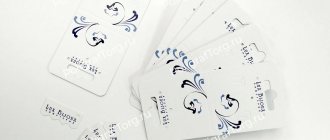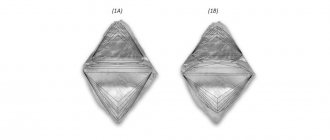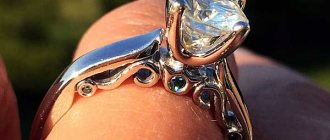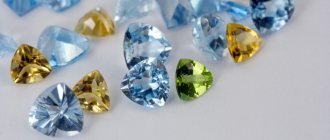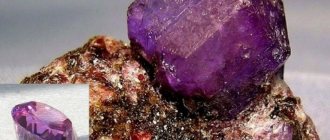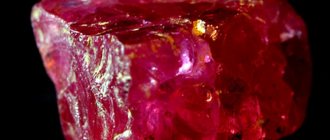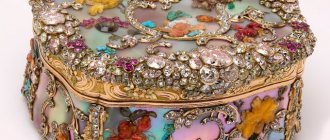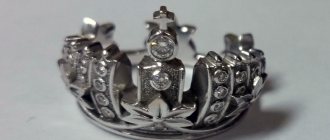What is jewelry marking
Marking involves applying two-dimensional DataMatrix codes to gold, palladium and platinum products, which are read by a scanner and contain complete information about the product and about each stage within the cycle of transition from manufacturer to retail owner.
The introduction of labeling is intended to protect buyers from falsification and fraud. The state is striving to get rid of the shadow market and unscrupulous entrepreneurship - both in the field of selling synthetic counterfeits and smuggling, and in terms of inflating the cost of sold jewelry. Labeling also allows full access to information and thereby simplifies the work of supervisory authorities.
Labeling deadlines
Mandatory labeling in the jewelry industry was supposed to start at the beginning of 2021, but market participants were not ready for the new requirements, and the deadline had to be postponed.
The new deadlines are determined by Decree of the Government of the Russian Federation of February 26, 2021 No. 270.
| March 1, 2022 | From this day on, products (materials and decorations) produced or imported into the Russian Federation must have labels with Data Matrix codes, and participants in trade turnover must register the following information in the DMDK:
Barcodes for precious metals bars can be applied to passports and certificates. |
| March 1, 2023 | Each product item must have a marking code. Without a nanotag, you cannot produce or import “jewelry” from abroad, but for now you can store the remainder in a warehouse. |
| March 1, 2024 | Physical nanotags must be applied to all residues by this date. From March 1, 2024, stores will not be able to sell jewelry without a marking code. |
Which products are subject to labeling?
The list of precious metals, stones and products made from them that are subject to mandatory marking is determined by Decree of the Government of the Russian Federation dated March 24, 2018 No. 321. This list includes:
- diamonds (cut and uncut);
- rubies, sapphires and emeralds;
- unwrought silver and gold;
- monetary gold;
- raw or powdered platinum and palladium;
- jewelry and parts thereof made from silver, gold and other precious metals.
Marking order
Unlike other goods, the labeling of jewelry is controlled not by the CRPT, but by Goznak. Therefore, participants in the turnover of jewelry products will work with the GIIS DMDK system. Goznak will also provide unique years of marking.
GIIS DMDK - State integrated information system in the field of control over the circulation of precious metals and precious stones.
What the jewelry labeling process will look like in general:
1
The manufacturer or importer orders a code for each product from Goznak, applies the received code in the form of a label on the tag and marks on the product itself.
2
When the finished product is transferred to the distributor, the code is read, and all information about the movement of goods is transferred to the GIIS DMDK.
3
During retail sales, the cashier also scans the marking code, information about this is automatically sent to the GIIS DMDK, and the jewelry is excluded from circulation.
Gold, precious stones, precious metals, as well as products made from them are subject to marking:
- diamonds (including rough);
- rubies;
- diamonds;
- sapphires;
- emeralds;
- platinum and palladium powder;
- Golden coins;
- gold and platinum jewelry.
Marking of silver and silver products has not yet been introduced. The mandatory labeling requirement also does not apply to products weighing up to 3 grams.
Features of marking and branding of jewelry
The purpose of marking is not only to identify jewelry with or without stones, but also to brand its component parts. Nanomarks must be present on the jewelry itself and on all precious stones inserted into it. The main problem in this case lies in technological solutions.
When branding stones, their presentation and characteristics should not be “suffered.” That is, the process of applying nanomarks should exclude the influence of elevated temperatures and high pressure. In addition, the applied identification means must be compatible with modern production processes and logistics solutions. The nanomarker developed so far for processed diamonds is only visible at 500x magnification and is intended primarily for professionals rather than end users.
There are still some technical limitations when applying a mark to a finished product. If the mark is placed simultaneously with the assay mark, then during subsequent processing it may be erased, since the jewelry will then have to undergo tumbling and polishing. The most convenient option is to transfer the application of the sample and mark to the final production cycle.
It was the technical difficulties of the process that did not allow the launch of a mandatory jewelry labeling program in Russia in January 2021, as previously planned.
Do you want to get a turnkey solution for implementing labeling?
30% cheaper than the market due to remote implementation.
We will start working on the day you contact us! More details
What is GIIS DMDK
GIIS DMDK is a unified information platform for interaction between participants in the precious metals and precious stones market, government control and supervision bodies, as well as other interested federal executive authorities.
With the help of GIIS DMDK, interaction between participants in the circulation of jewelry is ensured among themselves and with regulatory authorities. Information about product lots in the system contains a detailed inventory and identifiers. If necessary, counterparties can contact the system and receive a reconciliation report.
Using the system data, you can generate statistical and reference reports.
To participate in the labeling of jewelry, you must register in the GIIS DMDK and gain access to your personal account. To register, you must fulfill a number of system requirements, including installing an electronic signature.
"Astral-ET" is a reliable electronic signature for any purpose, including for working with government information systems.
Who will provide information to the new system?
These are federal executive authorities, the Central Bank of the Russian Federation and credit organizations, Gokhran of Russia, legal entities and individual entrepreneurs who carry out transactions with precious metals, precious stones and products made from them and are specially registered, namely:
- jewelry production
- trading houses working with precious metals and precious inserts
- retail jewelry stores
- pawnshops, purchases and consignment jewelry stores
- online stores.
All organizations that enter data into this system will be required to assign special accounting codes to jewelry, which can be obtained by first sending a request to the GIIS DMDK or during the export of batches to the new system. They will be used in the labeling of these goods. And before starting work in GIIS DMDK, it is necessary to register initial balances in the system.
What will organizations need to label costume jewelry?
- Registration in the system and agreement with the operator GIIS DMDK.
- Enhanced electronic digital signature.
- A 2D scanner that will read codes of marked products.
- Software for the entire cycle of working with labeled goods.
It will be possible to find unmarked items on sale before July 1, 2021, but after this date, the sale of both new and used jewelry without marks will entail liability.
Pyotr Slizky, Deputy Chairman of the Self-Regulatory Organization “Association for the Development of Pawnshops” , said: “Administrative and criminal liability is provided for the sale of goods without labeling (Article 15.12 of the Administrative Code of the Russian Federation, Article 171.1 of the Criminal Code of the Russian Federation). Administrative liability involves a fine of up to 300,000 rubles with confiscation of the items of the administrative offense. Criminal liability – up to imprisonment for a term of up to 6 years with a fine of up to 1 million rubles or in the amount of wages or other income of the convicted person for a period of up to 5 years, or without it.”
Will the marking affect the work of pawnshops?
The innovations will affect pawnshops from August 2021: it will be possible to hand over both marked and unmarked jewelry there, but for resale, tags will have to be applied.
Petr Slizky explained how the new scheme will work using the example of pawnshops: “Both jewelry with and without markings will be accepted as collateral. If the client repays the loan, the pledged product will be returned to him without markings. If the loan is not repaid on time, then at the end of the grace month, the pawnshop, before selling (selling) the jewelry, will be required to mark it in the assay office and enter information about it into the information system.”
How will products coming from abroad be labeled?
Imported jewelry products will need to be entered into the system prior to state control.
What you need to mark jewelry
To participate in the labeling system you must:
Receive an enhanced qualified electronic signature (CES). This can be done in one of the certification centers accredited by the Ministry of Digital Development of the Russian Federation. Obtain a certificate from the Federal Tax Service confirming the absence of debts. Register in the GIIS DMDK system. Prepare equipment for working with markings: a cash register with software and a fiscal drive that work with markings, 2D scanners for reading marking codes, label printers for printing marking codes on tags. Nanomarks are applied to jewelry by the Federal Assay Office: you don’t need to buy or configure anything for this. Become a member of the automatic identification association GS1 RUS. Sign an agreement with Goznak for the provision of marking codes in the form of a DataMatrix code.
To work with CEP, you will need additional software:
- cryptoprovider CryptoPro CSP - provides encryption and secure transmission of certified data;
- web browser Sputnik, Yandex.Browser or Chromium-gost;
- CryptoPro EDS Browser plug-in is a program for using signatures on web pages.
Also, participants in the jewelry trade will need equipment for marking and accounting automation:
- Online cash register - to automate payments to customers. The cash register transmits information about the sale to GIIS, after which the code is removed from circulation.
- 2D code scanner - for reading barcodes on transport packages, labels, certificates, passports and other media during acceptance, shipment, inventory in warehouses and sales areas.
- Label printer with Data Matrix codes - for printing labels for finished products, materials and warehouse balances.
- Data collection terminal (DCT) - for any operations in warehouses where barcode accounting is required. The terminal reads the information in the code, stores it in its memory, and also sends it to the commodity accounting system.
Labeling, packaging, transportation and storage of jewelry
Category: Various non-food products
Jewelry made from precious metal alloys is marked not only with a brand and name tag, but also with a label that is hung from the product on a thread and sealed. The label indicates the name or trademark of the manufacturer, name, article number and code of the product, OST or TU number, name of the precious metal, sample of the precious metal alloy, weight of the product, price per gram (for weight products), name, quantity and weight of the insert with an accuracy of 0.01 g, the price of the product. The Quality Control Department stamp is affixed to the reverse side of the label, and for rings and bracelets, their dimensions are affixed in millimeters. Products whose design does not allow the attachment of a permanent label are marked with an unsealed label, which is placed in individual cases along with the product.
Transport, group and individual packaging of jewelry must ensure the safety of the quality indicators of the products and their quantity during transportation and storage. Jewelry made from precious metal alloys is transported via special communications in wooden boxes lined with a whole piece of fabric. A packing list is placed in the boxes indicating the name of the manufacturer, name, article number and code of the product, standard number, name of the precious metal, sample, number of group packages in pieces, number of products in each package in pieces, number of products in pieces, net weight of products , dates and package numbers, packer numbers. The ends of the twine after stitching and the seams are sealed with the sender's wax seal.
Jewelry made from precious metal alloys must be stored in fireproof metal cabinets, sealed with the personal seal of financially responsible persons. Cabinets must be placed in special rooms.
Jewelry Packaging
According to OST 117-3-002-95 “Jewelry made from precious metals”, jewelry must be packaged in individual, group and transport containers.
Individual packaging can be made in the form of: paper bags, covers (bags) made of plastic film, boxes made of various materials or cases. The possibility of using cases as individual containers, as well as the size and features of their design, are agreed with the customer.
Requirements for group packaging are determined by the supply contract. The most commonly used group packaging is cardboard boxes. Products made of precious metals (except for products with precious inserts) are placed in group containers in the following quantities:
1. Smooth wedding rings - 10 or 20 pieces.
2. Rings with inserts - 5 or 10 pieces each.
3. Earrings - 5 or 10 pairs.
4. Pendants - 5 or 10 pieces each.
5. Chains - 5 or 10 pieces each.
6. Cutlery - 6 or 12 pieces.
Products of the same article must be placed in group containers.
Allowed:
1. Wrap the products individually in paper and place them in group containers (i.e., without using individual containers).
2. Place decorations mounted on a sheet of cardboard.
Table serving items and interior decorations, wrapped in paper and placed in cases or boxes, are allowed to be packed in transport containers without using group containers.
A packing list must be included in group containers containing weighed items. A packing list is not included in group containers with non-weighted products, as well as products with inserts made of precious stones. Group containers with products must be sealed by the manufacturer. The seal must have a clear imprint.
Products placed in group containers, cases or boxes are placed in transport containers. Packaging of products in transport containers must be carried out in accordance with the requirements of special communications. When packaging products equipped with certificates, the certificates must be placed in the transport container. The weight of the transport container with the products packed in it should not exceed 10 kg, unless there is a special clause in the supply contract.
Jewelry marking
Each piece of jewelry must have an assay mark, consisting of a main hallmark and a name tag. In addition, products made of precious metals must have a label indicating the following details:
- on the front side the name and trademark of the manufacturer, the name of the product, the code of the product, the name and standard of the precious metal, the mass of the product in grams, the retail price of the product;
- on the reverse side the size (in accordance with the type of product), name of the material, inserts, designation ND, QC stamp.
For products with inserts made of precious stones, in addition, indicate the month and year of manufacture, batch number, ND for the insert. Inserts made from natural diamonds contain additional markings in accordance with the “4C” system: shape and type of cut, carat weight, color group, clarity group, cutting and processing quality group.
Jewelry labels are attached with white threads and sealed. If the label cannot be attached to the product, it is placed in individual containers or attached with special glue.
Group packaging for products made of precious metals (except for sets and sets) must also have a label with the following details: name of the manufacturer, name and code of the product, name and fineness of the precious metal, weight of products in grams, retail price in rubles, number of products of each size (for rings, bracelets and chains), name of insert material, number of products with inserts of each color, packaging date, packaging number, packer's stamp, gross weight in grams, standard designation.
The shipping container indicates: the name of the organization, the manufacturer is subordinate to the curtain, details of the manufacturer, details of the recipient, gross weight in kilograms (grams), packaging number. Warning inscriptions are applied to the side walls of the transport container: “Caution, fragile”, “Afraid of dampness” or images of special warning signs. The marking of transport containers must be contrasting with the color of the container and legible.
Transportation of jewelry
Jewelry is allowed to be transported by all types of transport, subject to transportation rules that ensure their safety.
Products made of gold, platinum and palladium are transported by postal parcels through special communications. Silver products are transported by postal parcels through post offices.
Basic rules for storing jewelry
Jewelry displayed in retail establishments, in cabinets and on display cases is placed in special velvet trays or cases. Cabinets and display cases must protect products from dust and moisture. Displayed jewelry is periodically wiped down.
The stock of jewelry must be stored in fireproof cabinets located in a dry, heated room, without sudden temperature fluctuations, in a systematic manner, i.e., by type, article number, etc. Jewelry put up for sale is returned to fireproof cabinets after the end of the working day. The place where valuables are stored is sealed.
Jewelry is inspected and inventoried every 10-15 days. Gold and platinum products are weighed with an accuracy of 0.01 g, silver - up to 0.1 g.
Rules for handling and caring for jewelry
Caring for jewelry has always been and remains a pressing problem for those who have such items and want them to serve them as long as possible. Many people understand this problem in a simplified way, believing that it involves only one question: how to remove accumulated dirt, i.e., how to clean the product and give it a renewed look. In fact, the problem of caring for jewelry is complex and includes several components: proper wearing of jewelry, its proper storage and care.
First of all, you need to decide what kind of jewelry you will purchase: will it be used daily or only on special occasions; dress separately or with existing jewelry. Much depends on what materials and environments the product will come into contact with. There are so-called safe wearing areas and high-risk areas. For example, earrings are worn in a safe area, and a ring is worn in an area of increased danger, since hands can come into contact with substances such as soap, surfactants, etc. Therefore, earrings are reliable when used with a relatively soft stone, for example, opal or pearls If the insert in the ring is made of opal or pearls, then wearing such a ring every day is not recommended, due to the low wear-resistant insert and the increased risk of damaging it. Obviously, inserts made of wear-resistant minerals can be used in any jewelry. (Recall that wear-resistant minerals are those with a Mohs hardness equal to or greater than 7.)
In addition, you need to know what certain stones react to most, and what the consequences of such a reaction are. For example, diamonds actively absorb dirt, especially fats. Epidermal scales, sebum, cosmetics and ordinary dust quickly settle on diamonds, reducing their brightness and play of light. Therefore, diamond jewelry needs to be cleaned regularly. To a lesser extent, this property of contamination is also inherent in other minerals. Minerals such as topaz or tourmaline become highly electrified when heated or rubbed and begin to actively absorb household dust. Almost all stones become dirty over time, but this is most noticeable in the case of colorless or lightly colored stones.
Some stones change color when heated or when exposed to direct sunlight, which has a significant ultraviolet component in the spectrum. Sunlight especially noticeably changes the color of red-brown and golden topazes, amethysts and pearls, which “fade” and lose their original color. Other stones change color in daylight and evening light like “chameleons,” such as alexandrites and peridots. All this should be taken into account when choosing jewelry with inserts.
Finally, you must always remember that minerals, and therefore the inserts made from them, are relatively fragile and can either split or develop cracks from sharp impacts. Very fragile ones include emerald, chrysolite and some others. Therefore, it is recommended to handle jewelry very carefully and carefully.
Jewelry should be stored in tightly closed boxes, cases or caskets specially designed for this purpose, which protect it from dust and light. You should not leave jewelry near radiators or in the bathroom - this applies, first of all, to silver, which darkens from moisture and becomes covered with mold. Silver should always be stored in a dry place and in the dark. After removing the product, you need to wipe it with suede or a flannel cloth. It is necessary to wipe the product every time after it has been in your hands.
When performing household (or other physical) work, it is recommended to remove all jewelry, especially rings. They can be easily scratched and lose their shine.
The second rule is to avoid contact of jewelry with chemicals and chemical reagents. Avoid contact of jewelry with mercury, sulfur and iodine, which leave stains that are difficult to remove. When using cosmetics (ointments, creams) prepared on the basis of mercury and its salts, white spots appear on gold products and the products are destroyed, therefore, it is not recommended to wear gold products when using cosmetics based on mercury.
The third rule concerns the actual cleaning of jewelry. It is necessary to wipe the jewelry you wear with a flannel or suede cloth as often as possible, which will help put off serious cleaning for a long time. It is enough to hold a machine-woven chain or bracelet for several minutes in a warm soapy solution, in a diluted Fairy-type washing solution, sweetened clean water or water with the addition of a small amount of ethyl and ammonia. To clean products, can you use a weak solution of a mixture of ammonia and ethyl alcohol in water? This solution cleans gold especially well, but you should not put blackened silver in a solution of ammonia.
Currently, the industry produces special compositions for cleaning gold products and, separately, silver products. These formulations are packaged in convenient small volume bottles, relatively cheap, with a long shelf life. The bottle labels indicate the rules for handling the solution.
Products and inserts must be cleaned carefully and carefully, since dust and dirt contain quartz microparticles that can scratch the metal elements of products or inserts that are softer than quartz. Jewelry inserts with glue should be treated especially gently - they should be cleaned with a soft brush in a solution of washing powder. For stones with a hardness rating below 5 on the Mohs scale (for example, turquoise, pearls, corals, moonstone, malachite, amber), the use of powder is undesirable. Dirt can be easily removed from them with a soap solution or ethyl alcohol.
After cleaning, it is best to “dry” any product, except those with pearls, with pure alcohol or wipe it dry. Otherwise it will quickly fade again. It is not recommended to expose jewelry to alkaline detergents containing chlorine and iodine. Dark spots of iodine that appear on gold can be removed by immersing the product for 15-20 minutes in a solution: 1 teaspoon of hyposulfite (amateur photographers always have hyposulfite) per glass of water.
Cutlery made of silver (silver plated) also tarnishes when in contact with food containing acids. Darkening of silver items is possible when they are stored in packaging material (paper, cardboard) containing sulfide sulfur. Therefore, when storing silver items, it is necessary to use parchment paper.
Dark stains on silver cutlery can be removed by cleaning with chalk or tooth powder.
The procedure for removing dark plaque on such products:
- wash with warm soapy water;
- prepare a gruel (a mixture of ammonia and chalk or tooth powder);
- apply the mixture to a soft (flannel) cloth;
- clean the product until dark spots are removed;
- rinse the product with hot water;
- wipe with a soft cloth.
You can remove dark plaque by washing silver items in hot water with the addition of soda (at the rate of 50 g of soda per 1 liter of water) or in warm soapy water with the addition of ammonia (at the rate of 1 tablespoon of ammonia per 1 liter of water) .
Knives are stored separately from spoons and forks, as a sharp knife blade can scratch the surface of silver items.
If stains or plaque cannot be removed after the proposed methods, or if the jewelry is heavily soiled, especially with an openwork top, it is better to take the jewelry to a jewelry workshop, where specialists will clean it ultrasonically using special cleaning and washing solutions.
How does marking work at different stages of jewelry circulation?
Each market participant has its own algorithm of actions.
Mining company:
- forms raw materials batches;
- sends a request for codes and labels each package;
- ships labeled raw materials.
Depending on the project, shipment can be carried out to the address of a refinery, a processor within the framework of a tolling scheme, or to the final manufacturer - in this case there is a change of ownership.
Manufacturer:
- receives raw materials;
- creates semi-finished products suitable for further production of jewelry;
- sends them for testing to the FPP;
- produces jewelry;
- sends it back to the Federal Chamber of Commerce for verification;
- orders marking codes and applies them to labels.
When registering semi-finished products in the accounting system, it is necessary to indicate information about the batch of raw materials used for their production.
Processor-manufacturer of jewelry:
- receives from the owner cargo that has undergone the marking procedure;
- manufactures products that meet the requirements;
- sends them for testing to the FPP;
- orders a separate code for each product and places it on the tag and on the packaging for further transportation.
Refinery
Refining is the purification of a precious metal from impurities, which ultimately increases its value. This service does not provide for the transfer of ownership. As part of the labeling, the enterprises involved in the processing cycle:
- clean raw materials;
- fully or partially make a return shipment to the owner.
The owner, in turn, confirms the fact of receiving refined precious metal and enters information about this into the GIIS DMDK.
Wholesalers and buyers:
- register a change of ownership after receiving jewelry from the manufacturer;
- divide products for subsequent distribution to retail stores.
Retail store:
- accepts goods from contractors;
- records the transfer of ownership in the accounting system;
- when selling to the final buyer, scans the marking code printed on the tag.
As a result, the information comes from the online cash register to the fiscal data operator (FDO), who, in turn, informs the GIIS DMDK about the withdrawal of the product from circulation.
Pawnshop
Pawnshops sell jewelry that was not purchased by the owner or that was confiscated from him. The pawnshop applies for marking data and applies it to the products. At the same time, jewelry can be sold both wholesale and retail, while simultaneously excluding jewelry from circulation.
Text of the book “The Shine and Poverty of Costume Jewelry. Everyday jewelry in Russia and the USSR, 1880–1980"
The Rise of Soviet Art Nouveau (1960s)
In the mid-1960s, wide and rather long skirts were replaced by miniskirts and small straight-cut dresses.
The beads immediately lengthened. Particularly fashionable was the combination of individual beads separated by sections of chains or beads (ill. 124). Less common were long beads with a sliding ring that adjusted the length of the hand (ill. 124a; 124 c). One of the options for fashionable beads can be seen, for example, in the photograph of film actress Elsa Lezhdey (ill. 124b). 124. Variegated beads. Glass, metal. Length 140. Czechoslovakia. 1960s
Beads. Glass, metal. Length 144. Czechoslovakia. 1960s
124a. The beads are light blue. Glass. Screw lock with caps. Adjustable brush length. Length without brush 91, ring width 3.2.
Czechoslovakia. 1960s
Of course, such beads did not immediately appear on sale, so they tried to re-string the short beads that had gone out of fashion by inserting either fishing line, beads, or pieces of glass tubes between the beads. Lucky women who worked in research institutes or in factory laboratories could order such tubes from a glassblowing workshop, break them into pieces and use them to arrange obsolete beads (ill. 125).
124b. Postcard with a photograph of Elsa Lezhdey, 1967
124s. Magazine of the Tallinn fashion house Siluett. 1969, No. 2, p. 8
New trends, of course, also affected the craftsmen who worked with amber. In the magazine “Decorative Art of the USSR” (No. 6, 1959, p. 25) an article by M. Zhukov appears, in which the author clearly condemns the available assortment of amber products: “...amber brooches that can be seen on sale, as a rule, represent with either cherries, or leaves, or, finally, grapes. Beads are always round and differ from each other only in size.” The first attempts to preserve the pristine beauty of amber in jewelry date back to this time. A variety of necklaces, pendants, hryvnias, rings, and earrings made of amber appear, made in a completely new style (ill. 126). A wonderful addition to the new silhouette were long beads made of raw amber: transparent yellow and honey, opaque yellow, white and almost black. The usual length of these beads was 60–80 cm, and then everyone re-threaded them at their own discretion. It was allowed to sell amber only in state stores, so it was extremely difficult to get it. People resorted to tricks: for example, one of the fashionistas of the 1960s made beads by gutting the amber picture “Oak Tree” (ill. 127).
125.
Homemade beads.
Plastic, beads. Length 90 and 86. Russia. 1960s
Homemade “pearl” beads (fragment). Glass. 1960s
The black market in the Baltic resorts, especially Palanga, more or less successfully filled the gaps in state trade. Women wandered around the flea market, hung with amber beads, like bunches of dried mushrooms. They were pursued by vigilantes. Therefore, for some time they moved to the women's beach of Palanga, where dressed vigilantes could not appear. The sight was exotic: a crowd of naked Eves, hung with amber beads and bracelets. The authorities, however, were not asleep either, and soon detachments of vigilantes appeared on the beach, undressed, but with bandages on their arms. The beach was empty instantly. Only stunned customers remained. But when the warriors left, everything returned to normal.
126. Amber jewelry 1960-1970s.
Beads. Amber. Length 80
Beads. Amber, metal. Length 110, pendant 2.5
Cufflinks. Dimensions 4x3.3; 4x2.5
Brooch. Dimensions 4x6
127. Beads with pendant. Amber, metal. Baltics. 1960-1970s
Homemade beads. Amber, metal. 1960-1970s
Naturally, manufacturers of plastic jewelry also did not stand aside. A lot of plastic beads appeared - usually horrifying in appearance, but one day among them there were quite elegant ones, made of epoxy resin (Fig. 128).
Czech beads remained prestigious as before. Sometimes these beads were even able to replace the “universal equivalent”. Thus, the character of Victoria Tokareva’s story “It is possible and it is not possible,” Marusya gave a village resident bright Czech beads, and in return received an icon in a silver frame.
128. Beads. Epoxy resin. Length 86. Round carabiner lock. Russia. 1960-1970s
The beads are yellow transparent. Plastic. Plastic screw lock. Length 95. Germany. 1920–1960
Yellow beads with black cubes. Plastic. Without a lock.
Length 63. Russia (?). 1950-1960s (?)
Necklace. Plastic, metal. Length 46.5. Russia. 1950-1960s
Brooch with pendants. Plastic. Hair pin. 3.8x1.8. Russia. 1950-1960s
It was a time of “thaw”; people were irresistibly attracted to everything new. In fashion and interior design, a style that was called abstract at that time became widespread. Old furniture was replaced by wooden parallelepipeds on high legs, and paintings and carpets on the walls were replaced by fashionable prints and embossing. The view on fashion jewelry also changed. In the article by M.A. Ilyin “Jewelry and Fashion” (Decorative Art of the USSR. No. 5, 1959, p. 25), these new views are formulated as follows: “...jewelry, according to their nature and the materials used, should be divided into two groups. Some are made from precious metals and stones, including synthetic ones, while others are created on the basis of cheaper metals using glass, plastics, etc., forming an assortment that has recently become most often called “jewelry haberdashery.”
The last group of products owes its origin to capitalism, when urban philistines and bureaucrats began to show demand for cheap jewelry that looked “like the real thing.”
Having thus condemned “capitalist jewelry haberdashery,” the author in the same article writes about Soviet jewelry as a necessary element of a fashionable woman’s appearance: “Jewelry haberdashery has become a necessary part of not only festive, but also everyday dress. It can often be found even on outerwear...” Further, he formulates the requirements for the main decorative qualities of modern works: they “should consist of a memorable, well-found silhouette, a clearly readable pattern and original color combinations.” Laconicism, geometric shapes, generalized floral patterns, large sizes, in the author’s opinion, are the best fit for a modern costume. Indeed, both Soviet industry and women customers responded enthusiastically to the new fashion trends.
129. Top to bottom and left to right.
Brooch "singing girl". Metal, enamel. The inscription “1960 kui mina hakkan laule Maie” (“If I’m going to sing to Maie” is an analogue of the Latvian songs Līgo). 4.2x3.5. Estonia, 1960
Brooches “girl” and “boy” in folk costumes. Brass. 5x2.6 and 4.8x2.7. Latvia (?). 1960s
Brooch "Dance". Brass, blackening, stamping. Stamp "Tallin KJ". 4.1x3.1. State Art Institute of the Estonian SSR. 1966–1968
Brooch "tree". Metal, enamel. Brand "T32 Met". 4.2x3.7. Tallinn Jewelry Factory. 1962
Brooch "Bagpiper". Brass, blackening, stamping. Brand "Tallin KJ". 4.2x3.3. State Art Institute of the Estonian SSR. 1966–1968
Brooch “stylized flower”. Metal, enamel. 2.7x2.6. Baltic (?). 1960s
Brooch "Girl". Metal. 3.8x3.3. Baltics. 1960s
Brooch "flower". Brass, blackening, stamping. Brand "Tallin KJ". 3.1x2.6.
State Art Institute of the Estonian SSR. 1966–1968
Brooch "Nest". Metal. 3.5x3. Baltics. 1960s
Brooch with ornament. Metal. 2.3x3.3. Georgia(?), 1960s
Brooch “woman in national costume”. Metal, enamel. Pin clasp. Brand "Sh33". 4x2.7. 1960-1970s
129a. Brooch "Girl". Metal. Size 3x3.3 cm. Baltic. 1960s
Brooch "Girl in a headscarf". Metal, enamel. Diameter 4.7.
Brand "Moscow". 1960s From the collection of V.P. Golitsyna
Suddenly, hammered metal or metal and enamel brooches appeared in large numbers, designed in a new style (ill. 129). Among them, interesting brooches produced by the Tallinn Jewelry stand out. At the State Art Institute of the Estonian SSR in 1966–1968, a series of stamped metal brooches with ethnographic motifs was created. Usually they were branded “Tallin KJ”. The brooches, judging by the costumes of the characters, were somewhat different from them, produced in Latvia. There are brooches of the same type with stamps MYuZ (Moscow Jewelry Factory) and KYUZ (Kostroma Jewelry Factory). Most often, there are no indications about the manufacturer at all. It seems that every woman in the Soviet Union had one of these brooches in the form of an irregular square with the image of a girl’s head and is still extremely common. It is also reproduced in a fashion picture in the Fashion Magazine for 1960–1961 (No. 4, p. 18). Another equally popular brooch was the “Girl in a Scarf” with the stamp “Moscow” (ill. 129a).
130. Jewelry with enamel (top to bottom and left to right)
Brooch "Peasant Woman with a Rocker". Metal, enamel. 4.5x3.8. 1960s From the collection of V.P. Golitsyna
Brooch “autumn leaves”. Metal, enamel. Brand "LF9". Diameter 5.1. Leningrad Jewelry Factory, 1959
Brooch “Dymkovo toy”. Metal, enamel. Brand “LU2M Made in the USSR”. 5.1x5.4. Leningrad Jewelry and Watch Factory, 1962
Brooch "matryoshka". Metal, enamel. 2.5x4.3. Brand "LYUZM". Leningrad Jewelry and Watch Factory, 1963
Brooch pendant. Brand “Made in the USSR LYu2M 2s”. 5.4x4.7. Leningrad Jewelry and Watch Factory, 1962
Brooch-badge “KSZh” (Committee of Soviet Women). Metal, enamel. Brand "LU7 M". 4.1x2.2. Leningrad Jewelry and Watch Factory, 1967
Brooch "Birches". Metal, enamel. Brand "LUZ M". 4x5.2. Leningrad Jewelry and Watch Factory, 1963
Brooch "Peasant Women". Metal, enamel. Brand "LU2M". 2.8x2.6. Leningrad Jewelry and Watch Factory, 1962
Brooch "Polar". Metal, enamel. Brand "LF9". 3.5x4.5. Author V.G. Povolotskaya. Leningrad Jewelry Factory, 1959
Brooch "reeds". Metal, enamel. 3x5.5. Brand "LF9". Leningrad Jewelry Factory, 1959
Brooch "leaves". Metal, enamel. Brand “LFO”, inscription “On the day of the 50th anniversary of March 8.” 4.6×3. Leningrad Jewelry Factory, 1960
Brooch with sailboats. Metal, enamel. Irregular rectangle 3.8x5.8. Brand “LU1 M Made in the USSR”. Leningrad Jewelry and Watch Factory, 1961
Brooch-badge "International Women's Day March 8th". Metal, enamel. Diameter 4.7. Brand "LUM". Leningrad Jewelry Watch Factory, 1960. (?) From the collection of V.P. Golitsyna
Triangular brooch. Metal, enamel. Brand “Made in the USSR LYu2M”. 5x6. Leningrad Jewelry and Watch Factory, 1962
Brooch "abstraction". Metal, enamel. 2.7x7.8. Brand “Made in the USSR LYu2 M”, 1962
The Leningrad Jewelry Factory (branded “LF”) produced spectacular brooches with hot enamel. Similar products were also included in the assortment of the Leningrad Jewelry and Watch Shop) (ill. 130). The number in the stamp after the letters corresponds to the last digit of the year of manufacture: for example, the stamp “LF9” means that the jewelry was made at the Leningrad Jewelry Factory in 1959. Later in 1969, the number began to be placed not after, but before the letters (M.M. Postnikova-Loseva and others. Gold and silver business of the 15th–20th centuries. M., 1983). Probably, some of these products were made for export, since some of them, in addition to the usual mark, had the mark “made in the USSR”. Leningrad brooches were distinguished by high quality and an unusually wide range. The decor of these brooches includes a fashionable “abstract” ornament, stylized plant elements, and folklore motifs. Among them you can find series released for the youth festival in 1957, and badges of the Committee of Soviet Women “KSZH” dating from the same year. The appearance of the latter was apparently timed to coincide with the renaming of the Anti-Fascist Committee of Soviet Women into the Committee of Soviet Women in 1956. In 1960, irregularly shaped brooches were issued with branches on a black background and a stamp on the back: “On the 50th anniversary of March 8.” On another brooch-badge, the inscriptions “International Women’s Day” and “March 8 March” are included directly in the ornament. Brooches with the image of the clown Oleg Popov, who enjoyed extraordinary success at that time, also date back to this time (ill. 130a). The variety of designs and subjects of these brooches is amazing. Often they acquired a completely different appearance due to a change in the background color (ill. 13Ob, 131). And sometimes the craftsmen dramatically changed the already familiar style and combined metal and enamel or made purely metal brooches with relief or through openings (ill. 132).
Information about the authors of the wonderful Leningrad brooches is scattered across various magazines, which are currently not easy to find.
130a. Brooch "Oleg Popov". Leningrad jewelry factory. Early 1960s From the collection of V.P. Golitsyna
130b. Brooch "road". Metal, enamel. Brand “LU2” “Made in the USSR”. 3.7x3.6. Leningrad Jewelry and Watch Factory, 1962
Brooch "curl". Metal, enamel. Brand "LFO". 2.8x4. Leningrad Jewelry Factory, 1960
Brooch "rays". Metal, enamel. 3.7x6. Stamp of insecurities, 1960s.
From the collection of D. and O. Matveev
131. Brooches with different backgrounds
Brooches "fern". Metal, enamel. Brand "LFO". Dimensions 2.6×3.8 Leningrad Jewelry Factory, 1960
Earrings. Metal, enamel. Brand “Made in the USSR, LYu2, M.” Leningrad Jewelry and Watch Factory, 1962
Brooches “leaves”. Metal, enamel. 1960s
"Dancing" brooches. Metal, enamel. Brand "ZHG". 2.5x4.4. Factory of artistic metal engraving, 1963.
From the collection of V.P. Golitsyna
Festival brooches. Metal, enamel. 1.5x5. "Moscow", without stamp. 1957 (?)
From Galina Gabriel’s article “The Long Road of the St. Petersburg Avant-Garde” (Russian Jeweler, 1998, No. 2–3 (7–8), p. 20) we learn that “the main figures in the struggle for the renewal of Leningrad jewelry art were then (late 1950s . – Years) artists Yuta Paas-Alexandrova, Rem Kharitonov, Vera Povolotskaya.” The most significant contribution to the development of a new style of inexpensive jewelry was made by Vera Georgievna Povolotskaya. In the memoirs of the chief artist of Russian Gems JSC S.M. Berezovskaya (https://skurlov.blogspot.ru/2011/10/blog-post_24.html) we read: “Vera Georgievna Povolotskaya is an Honored Artist of Russia, graduated from the Mukhina College in 1957 and began her career at the Leningrad Jewelry Factory. As a certified ceramicist, she initially worked on decorative tableware. By that time, the factory had started producing expensive trays and punch cups, decorated with enamels and other spreading cranberries in the neo-Russian style. Povolotskaya created a real revolution by developing sets, the items of which were distinguished by a modern design. The services were followed by decorations.
132. Top to bottom and left to right
Brooch with slots. Metal. 3.2x6.3. Brand "LU2". Leningrad Jewelry and Watch Factory, 1962
Brooch pendant "Bison". Metal, enamel. Brand “Made in the USSR LYu2M”. 5x5.2. Leningrad Jewelry and Watch Factory, 1962
The brooch is convex rectangular. Metal. Brand “LU2 M”, “Made in the USSR”. 2.5x5.9. Leningrad Jewelry and Watch Factory, 1962 From the collection of V.P. Golitsyna
Brooch with stylized flowers. Metal, enamel. Brand "LU2 M". 3.4x5.3. Leningrad Jewelry Watch Factory, 1962
Brooch curved trapezoid. Metal, enamel. Brand “LU2 M”, “Made in the USSR”. 2.5x7.1. Leningrad Jewelry and Watch Factory, 1962 From the collection of V.P. Golitsyna
Herringbone brooch. Metal, enamel. Brand “LU2 M”, “Made in the USSR”. 6.5x3.2. Leningrad Jewelry Watch Factory, 1962
Brooch with “turquoise” inserts. Metal, enamel. Brand “Made in the USSR LYU2 M”. 4.1x5.3. Leningrad Jewelry and Watch Factory, 1962
Brooch "Leningrad". Metal. Brand "Leningrad". 3.6x3.6. 1960-70s
From the collection of V.P. Golitsyna
Half-cylinder brooch. Metal, enamel. 1.6x6.3. Brand “LU2 M”, “Made in the USSR”. Leningrad Jewelry and Watch Factory, 1962.
Brooch "Rostr". Silver. Brand “LU2”, “Made in the USSR”. Sample "873".
2.5x5.9. Leningrad Jewelry and Watch Factory, 1962 From the collection of V.P. Golitsyna
Earrings. Metal, enamel. Brand “Made in the USSR, LYu2 M”. 2.5x1.4. Leningrad Jewelry and Watch Factory, 1962
Brooch - hairpin. Metal, enamel. 1.8x7.5. Brand "LUZ M". Leningrad Jewelry and Watch Factory, 1963
Barrette. Metal, enamel. 1x6.9. Brand “LU1 M”, “Made in the USSR”. Leningrad Jewelry and Watch Factory, 1961
133, 133a, 133b. Brooches by Lee Stein. Rhodoid. France. 1960-80s
Working almost all her life as an artist in the jewelry industry, Vera Georgievna created not only exclusive works, but also objects of mass, small-scale production. Penny brooches made of tombac and other non-precious materials, popular in the sixties and seventies, were made according to her sketches, for example, the famous enamel brooch, which became the trademark of the Beryozka store. As a result, thousands of Soviet citizens saw or wore her work without even knowing about the author’s name.” An article by I.V. is dedicated to the work of this outstanding artist. Shatalova “Jewelry Marathon of Vera Povolotskaya” (Russian Jeweler, 2008): “Vera Georgievna Povolotskaya is a significant name in the jewelry world. Her works occupy a place of honor in many museums in the country - the State Russian Museum, the State Historical Museum, the Armory Chamber of the Moscow Kremlin, museums in Kaliningrad and Yekaterinburg... The design of her designs was inspired by the aesthetic ideas of the time, when the slogan “Art into everyday life” replaced pretentious forms “Stalin's Empire style” came with simple and clear geometric forms. The new style was especially expressive in her costume jewelry - inexpensive brooches, bracelets and earrings made of tombac or other base metals, which were worn by all fashionistas of the Soviet Union at that time.” Perhaps the symbol of the Beryozka store was the brooch with images of birch trees, shown in Fig. 130. There you can also see V. Povolotskaya’s “Polar” brooch, the authorship of which was kindly helped to establish by a specialist in the field of jewelry art, I.Yu. Perfilyeva.
The elegant brooches created by Leningrad craftsmen are interesting to compare with the works of the famous French artist Lea Stein, who began working in the late 1960s. Unlike American costume jewelry oversaturated with shiny metal and rhinestones, Lee Stein's brooches captivate with their laconicism and grace (ill. 133, 133a, 133b). To this day, her “foxes,” “cats,” and “insects” enjoy great success. It seems that enamel Leningrad brooches, not inferior to them in quality and design, are still waiting for their worthy appreciation.
134.
From top to bottom and left to right.
Brooch "Swan". Metal, enamel. 4x5. Brand "P" in an oval. . Moscow, 1960s.
Brooch "Deer". Metal, enamel. 4x5. Brand “P” in a polygon, Pavlovo (?), 1960s.
Brooch "Space". Enamel, metal. Brand "ZHG". Pin lock. 2x5.5. Factory of artistic metal engraving, 1963
Brooch "Birds". Metal, enamel. 3.8x3.8. Brand “P” in a circle, Pavlovo (?), 1960s.
Brooch "Yachts". Metal, enamel. 4x3.5. Russia, 1960s
Brooch “Broken Flower”. Metal, enamel. Brand "HRU Pavlovo". 5x4.2. Pavlovsk Art and Crafts School. 1960s
Brooch "Night landscape". Metal, enamel. Pin lock. Brand "ShchZ" (?) Shcherbinsk metal haberdashery plant. Oval 4x6. Russia. 1960-1970s
Brooch "Petrel". Metal, enamel. 4x5. Brand “P” in a circle, Pavlovo (?), 1960s.
Brooch "Leaves". Metal, enamel. Dimensions 4x3.3.
Brand “P” in a circle, Pavlovo (?), 1960s.
Brooch "Stork". Metal, enamel. 2x2. Russia, 1960s
Brooch "Cat". Metal, enamel. 4.2x3.3. Russia. 1960-1970s
Brooch "Abstraction". Plastic. The lock has been replaced. 4x6. Russia. 1960-1970s
The brooches produced at factories in Moscow, Pavlov, Shcherbinka were much simpler in design and technology (ill. 134). Some of them bear the mark “KhRU Pavlovo” (arts and crafts school). In style they are close to Leningrad brooches, sometimes they are copied: for example, there is an aluminum copy of V. Povolotskaya’s “Polar” brooch. At the same time, among such brooches there are also more complex compositions: for example, a northern landscape, presumably made at the Shcherbinsky metal haberdashery factory. Inspired by our achievements in space, in the early 1960s a series of metal brooches was produced by the Moscow Metal Art Engraving Plant (brand “ZHG”).
134a. Children's brooches. From the collection of V.P. Golitsyna
Cheap earrings made in the same style, purely metal or with plastic inserts, also appeared. At this time, many factories, artels and even repair shops made jewelry that had become so popular. In particular, a mass production of small children's brooches with funny kittens, dogs, cartoon characters and children's books was launched (ill. 134a). Among them there are brooches from the Pavlovsk Souvenir Factory, Leningrad Jewelry Workshops, the Moscow Experimental Creative and Production Plant of the Russian Art Fund, etc. Detailed information about the corresponding stamps can be found in the reference book by Yu. Korzhik “Catalogue of Trademarks and Stamps on Badges”, 2001. Probably, these brooches alone could make an interesting collection, since, apparently, good professional artists were involved in their design.
135. Brooch. Jasper, silver. Lock with safety lock. Stamps “Ural”, “СУ2”, “873”. Rhombus 6x4. Russia, Sverdlovsk Jewelry and Cutting Plant, 1962
Pendant. Jade, metal. Dimensions with pendant: 4×2.5. 1960-1970s From the collection of V.P. Golitsyna
Pendant. Jasper, metal. Dimensions including pendants 7x5.4. Author's work. 1970s
Barrette. Jasper, metal. 1.6x5.2. Brand "RSZ". Leningradsky, 1963.
From the collection of V.P. Golitsyna
Bracelet. Jadeite (?), metal. 4x17. Author's work. 1960-1970s From the collection of V.P. Golitsyna
Suspension. Rhodonite, silver. Stamps “Ural”, “SYUZ”, “873”. Sverdlovsk Jewelry and Cutting Plant. 1963
In the Urals, the Sverdlovsk Jewelry and Cutting Plant produced jewelry made in a new style using ornamental stones: rhodonite, jasper, jade and others (ill. 135). Ural ornamental stones were also used in other factories, in particular in Leningrad. These developments turned out to be so successful that they fit into the changing fashion of the next two decades almost without changes. Craftsmen in artels and individual amateurs copied this style, and instead of noble minerals, for lack of anything better, they often inserted glass or plastic into pendants on a long chain.
Earrings, considered a despicable symbol of philistinism for a long time after the revolution, have returned to life. Since the early 1960s, girls began to have their ears pierced en masse. The most advanced ones did not engage in amateur activities, but did it at beauty institutes and walked around for the first month with strings in their ears. Then the strings were replaced with special medical earrings, sold in all haberdashery stores. These earrings looked like a small drop of blue or white plastic, set in a simple gilded silver frame, and, I remember, cost 78 kopecks. Instead of medical earrings, either grandmother's earrings or products from Soviet jewelry factories were inserted into healed ears, which just at that time began to produce relatively inexpensive gold earrings in the shape of a rhombus or a circle with a faceted star in the center and with simple earrings equipped with a safety lock. You could buy the same pendant on a chain to go with them.
136 and 136a. Book pendant. Mother of pearl, garnets, silver. Author N.G. Kolobkov. 1970s From a private collection
137. “Lizard” bracelet. Malachite, silver. Author N.G. Kolobkov. 1970s From a private collection
Mass production did not satisfy everyone, and therefore private jewelers became extremely active. Their activities were, of course, not entirely legal due to the state monopoly on the processing of precious metals and the ban on any business activity. But the ladies' community did not expose their favorite masters and widely used their services. Among them there were real virtuosos - for example, Nikolai Georgievich Kolobkov, who freely used any technique and was able to masterfully bring to life any client’s fantasies, from a miniature pendant book to a bracelet covered with the finest filigree with a malachite lizard (ill. 136, 136a, 137). At the same time, Dmitry Borisovich Skubenko, who specialized in cameos from shells, malachite, etc., worked with him (ill. 138, 139).
138. Cameos – pendant and earrings. Malachite, silver, beads.
139. Cameo – pendant. Sink, Author D.B. Skubenko. 1970s silver, beads. Author D.B. Skubenko. From the collection of A.V. Berkova 1970s
Finally, fashion magazines, which until then had been very little concerned with this aspect of women’s interests, began to pay attention to the problem of jewelry: “Modern jewelry is elegant strings of beads, various chains, pendants (sometimes in the form of a brush) and key chains, brooches, bracelets, consisting from links or rings. They are made of metal, ceramics, glass, plastics. Our natural resources are used for them - Ural gems, transparent amber, various types of wood.
140. Fashion accessories (International fashion congress. Moscow, 1961, pp. 80, 81)
Coming to life in the artist’s hands, these materials are transformed into wonderful jewelry: strings of beads made of sparkling rock crystal, painted porcelain and decorative beads made of wood.
Jewelry often combines different materials - this is one of the characteristic features of the fashion trend” (Fashion Magazine No. 72, 1963). At the fashion congress of the countries of the socialist camp, an entire spread was dedicated to modern accessories (ill. 140). An abundance of jewelry is featured, for example, in No. 1 of Fashion Magazine for 1967: on the cover you can see large plastic clips with a geometric pattern, and on the models there are clips, bracelets, and rings. In No. 2 and No. 3 of the same magazine, female models demonstrate traditional beads made of artificial pearls in several rows and lush Czech parures made of glass and metal.
Where to apply marking codes
Typically, jewelry contains two imprints:
sample
— it encodes information about the composition and volume of the precious metal
"name"
- it contains information about the manufacturer
Now two more identifiers will be added to them:
from March 1, 2022 - tag
or
a book tag
with a unique identification number and Data Matrix barcode
from March 1, 2023 - nanoengraving
in the form of a Data Matrix, which will be laser applied to each component of the jewelry and to all precious inserts.
The nanomark will be applied by the Federal Assay Office (FAP) along with the sample. The engraving is invisible to the human eye, its size will be 0.8x0.8 mm.
Using a special application on a smartphone, the buyer will be able to scan the barcode on the tag and receive detailed information about the product.
How and when to label leftover jewelry
For jewelry leftovers released before mandatory labeling began, special rules apply.
- Until January 15, 2022, wholesalers, stores and other market participants must enter into the GIIS information on the balances of precious metals, stones and finished products as of January 1, 2022.
- Before April 1, 2022, you need to re-take the inventory and enter current information taking into account goods sold from January 1 to March 31.
- From September 1, 2022, all “jewelry” declared as surplus must have marking codes. From March 1, 2023, the sale of jewelry is possible only with tags. Industry participants will have a year to engrave all remnants.
- From March 1, 2024, products without a nanomark can neither be sold nor kept on balance sheet.
"Astral.EDO" is a new service for electronic document management. Suitable for working with information systems, including interaction with GIIS DMDK. , and our specialist will contact you.

